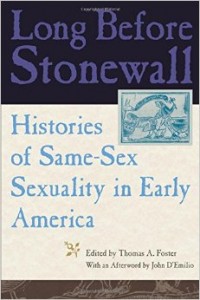 Long Before Stonewall: Histories of Same-Sex Sexuality in Early America
Long Before Stonewall: Histories of Same-Sex Sexuality in Early America
Edited by Thomas A. Foster
New York University Press. 405 pages, $25.
IN 1976, Jonathan Katz published one of the first comprehensive histories of same-sex sexuality in the United States. His Gay American History: Lesbians and Gay Men in the U.S.A. is credited with legitimating gay history as a viable subject for academic inquiry and providing a necessary starting point for this emerging field of study. Long Before Stonewall: Histories of Same-Sex Sexuality in Early America, contributes to and complicates this field considerably. Thomas A. Foster’s new anthology tackles a number of subjects not covered in previous works, collecting fourteen essays on subjects ranging from Spanish and Pueblo perceptions of same-sex sexuality in Colonial New Mexico to homoerotic depictions of the black male body in the early years of the Republic.
The strength of Long Before Stonewall lies in Foster’s selection of essays spanning the 16th to the early 19th centuries. When read together, they illuminate the complexity, breadth, and social impact of sexuality in history. For example, two essays by Ramón A. Gutiérrez and Gunlög Fur provide a refreshing take on the berdache—indigenous men who had sex exclusively with other men and wore the garments and performed the work of women. Gutiérrez points out that the berdache has often been appropriated by the gay liberation movement as a queer-positive icon embraced by many indigenous communities. This appropriation distorts the likely reality of the berdache, which Gutiérrez argues was a forced emasculation that could have been performed on the captured leader of an opposing tribe. These two essays pull evidence from a number of tribes ranging from the Pueblo of New Mexico and the Delawares of New England, avoiding the common pitfall of assuming that traditions are identical among various tribal communities.
While Gutiérrez and Fur focus their studies on gender crossing, Elizabeth Reis examines gender construction by charting the American fascination with intersexuality during the 17th century. This was a time when hermaphrodites were commonly thought of as men with inverted penises or women with large clitorises capable of sexual penetration. Such persons were seen as physical anomalies requiring medical attention, and the thought of an ambiguous gender identity raised concern among religious groups and courts of law. If a person could be either male or female, then they had the sexual ability to couple with both men and women—a situation society was vehemently unwilling to accept.
Mark E. Khann further documents how this preoccupation with gender impacted social policy, deftly arguing that prison reform after the American Revolution related directly to sexual desire. Believing activities such as masturbation and sodomy were directly linked to criminal behavior, prison reforms were designed to generate “chaste penal environments.” Gender segregation led to the establishment of women’s correctional facilities and juvenile prisons were created to prevent hardened criminals from corrupting and sexually exploiting the young. While ultimately unable to control sexual behavior completely, the understanding of sexual desire by prison reformers in the early Republic can still be found in correctional institutions today.
Stephen Shapiro’s essay “In a French Position” concludes the anthology by examining the homosexual society created in Charles Brockden Brown’s 1799 novel Ormond, or The Secret Witness. Shapiro begins his investigation by acknowledging a particular obstacle that has plagued sexuality scholars since Michel Foucault published his History of Sexuality in 1976. In it, Foucault argues that sexual identity is largely a contemporary creation, and that it has only been around since the late 19th century. Before this time, there were homosexual activities, but not identities. By focusing on this shifting uses of terms, Shapiro makes the radical argument that Foucault failed to deal with how the terms such as “sodomy” and “homosexuality” affected a person’s behavior. By categorizing sexuality as either an act or an identity, we are unable to grapple with the intricacies that underlie the subject. Shapiro continues this radical challenge to “established” scholarship by proving how, in the case of Brown’s Ormond, late-18th-century America could recognize sexuality as a complex collective experience rather than as an act or a personal identity.
Long before the Stonewall riots, or Foucault for that matter, nonconforming sexual identities were recognized by society. Butting up against an established theoretical foundation and providing an alternative to recent histories inspired by Foucault’s social constructionism, Long Before Stonewall represents an important contribution to American historical and sexuality studies. The specificity of the essays, which dot a considerable historical expanse, points to the large gaps in current knowledge of GLBT social history and of the need for more research.
____________________________________________________________________
Eric Colleary is a doctoral candidate in Theatre Historiography at the University of Minnesota.





